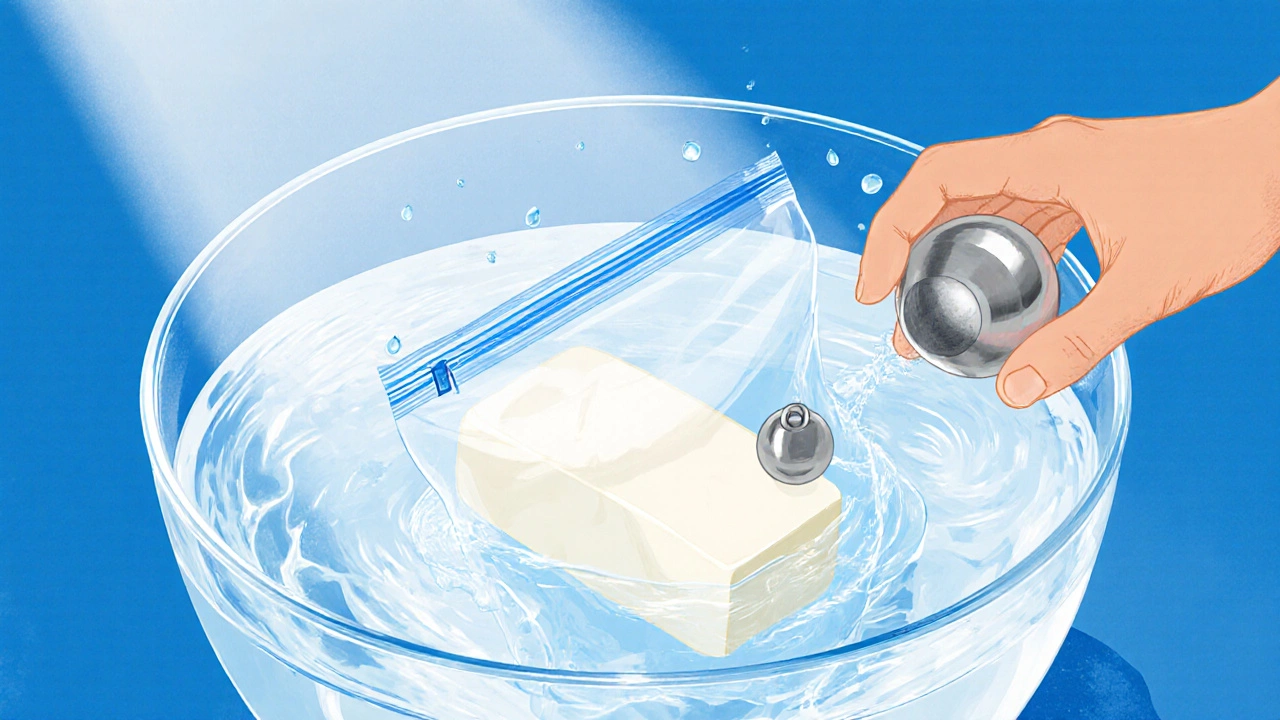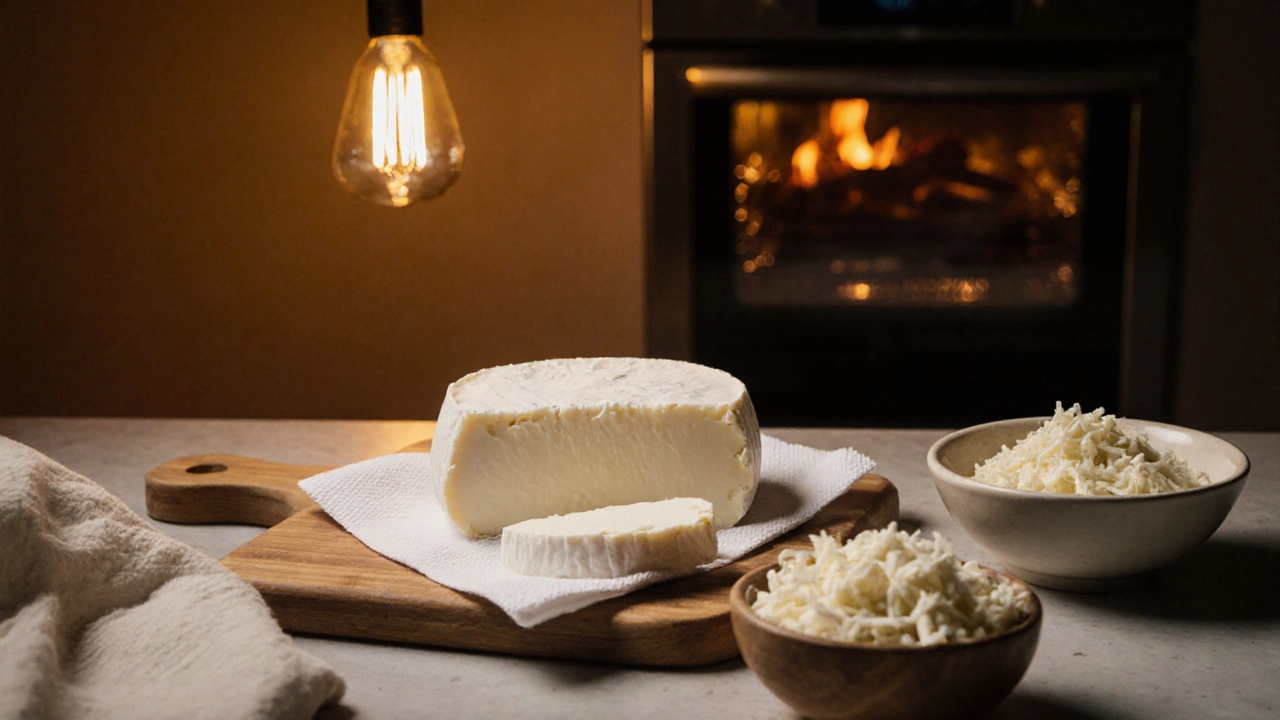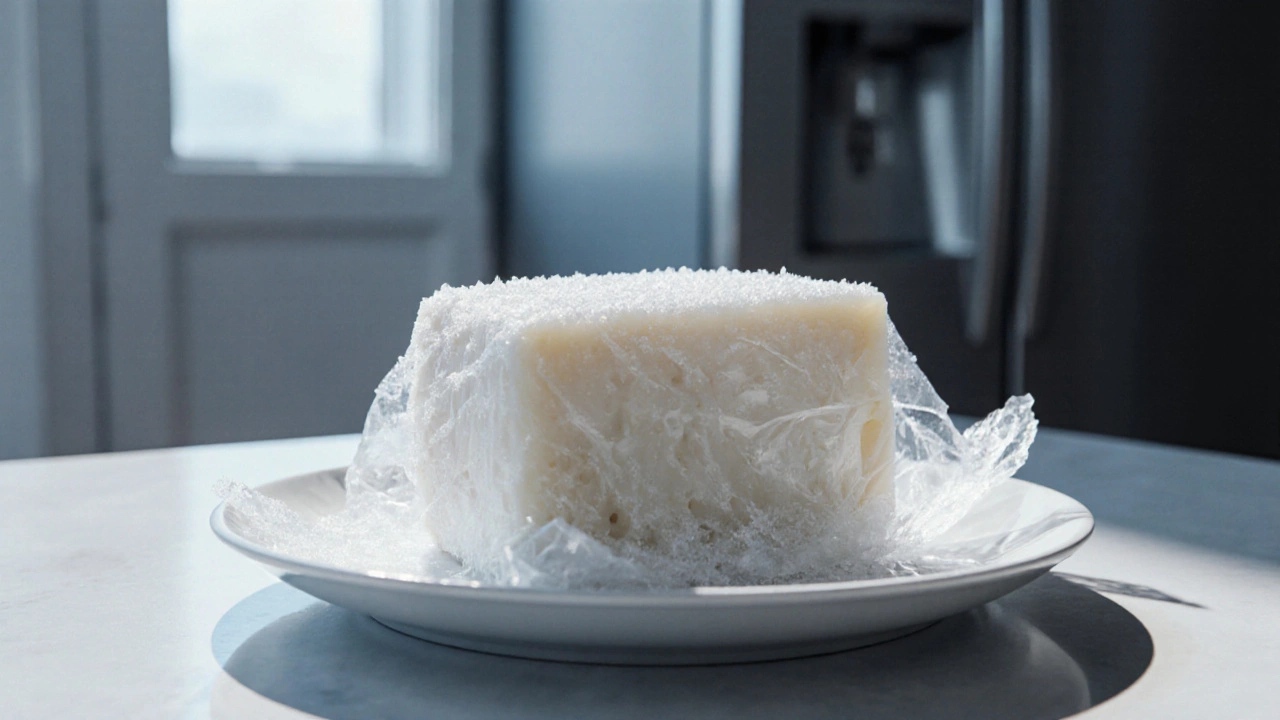When you pull a block of Mozzarella cheese is a semi‑soft Italian cheese known for its stretchiness when melted, made from water buffalo or cow’s milk from the freezer, the first thing you wonder is how to get it back to that perfect melt‑in‑your‑mouth softness without turning it grainy or unsafe.
TL;DR - Quick Cheat Sheet
- For best texture: move the cheese from freezer to the refrigerator and let it sit 12‑24 hours.
- When you’re in a hurry: seal the block in a zip‑lock bag and submerge in cold water for 30‑45 minutes.
- Microwave only if you plan to use the cheese immediately in a cooked dish; use low power and short bursts.
- Never refreeze a partially thawed block - it loses moisture and can develop off‑flavors.
- Always keep the cheese at defrost mozzarella temperatures above 35°F (2°C) but below 40°F (4°C) before you cook.
Why the Thawing Method Matters
Moisture and protein structure are the two things that decide whether melted mozzarella stretches like a dream or turns rubbery. A slow, controlled thaw lets ice crystals melt gradually, preventing the cheese from shedding excess whey. Fast, uneven warming can cause water to separate, making the cheese crumbly and increasing the risk of bacterial growth. That’s why choosing the right method isn’t just about speed - it’s about preserving flavor, texture, and safety.
Method 1: Slow Thaw in the Refrigerator
Your Refrigerator should be set between 35°F‑40°F (2°C‑4°C). This is the gold‑standard for thawing any dairy product.
- Remove the mozzarella from the Freezer and keep it in its original packaging or place it in a sealed container.
- Lay the package on a plate to catch any condensation.
- Allow it to sit undisturbed for 12‑24 hours, depending on block size. A 1‑lb (450 g) block usually needs about 18 hours.
- Once fully softened, pat the surface dry with a paper towel before using.
Pros: Best texture, no risk of partial cooking, safe for long‑term storage after thaw. Cons: Takes the most time.
Method 2: Cold Water Bath (Speedy and Safe)
This technique accelerates thawing while keeping the cheese cool enough to stay in the safe zone.
- Leave the mozzarella in a resealable Vacuum sealed bag or a zip‑lock bag, removing as much air as possible.
- Fill a large bowl with cold tap water (around 40°F/4°C).
- Submerge the bag completely, weighing it down if needed.
- Swap the water every 10‑15 minutes to keep it cold.
- Check after 30 minutes; a typical 8‑oz (225 g) block should be pliable within 30‑45 minutes.
- Dry the cheese before use.
Pros: Faster than the fridge, maintains safe temperature. Cons: Requires monitoring and occasional water changes.

Method 3: Microwave (When You’re Really in a Rush)
The microwave is the quickest route, but it’s also the easiest to over‑do.
- Unwrap the cheese and place it on a microwave‑safe plate.
- Set the microwave to 30% power (or “defrost” mode if it has one).
- Heat in 15‑second bursts, rotating the cheese after each burst.
- Stop as soon as the cheese feels soft enough to cut - typically 45‑60 seconds total for a small block.
- Use the cheese immediately in a cooked dish; don’t let it sit, as residual heat can continue to cook the proteins.
Pros: Lightning‑fast, great for pizza or pasta that will hit the oven right away. Cons: Can cause uneven texture, risk of melting edges.
Method 4: Defrost While Still in Vacuum‑Sealed Packaging
If the cheese was frozen in a vacuum‑sealed pouch, you can let it sit in the fridge for a shorter period because the packaging limits moisture loss.
- Place the sealed pouch on a plate in the Refrigerator.
- After 6‑8 hours, gently press the pouch; if it gives easily, it’s ready.
- Open, pat dry, and use as desired.
Pros: Minimal handling, retains original flavor. Cons: Still requires several hours.
Quick Comparison of Thawing Methods
| Method | Time Needed | Texture Impact | Safety Rating |
|---|---|---|---|
| Refrigerator | 12‑24 hrs | Excellent - retains stretch | ★★★★★ |
| Cold Water Bath | 30‑45 mins | Very Good - minimal whey loss | ★★★★ |
| Microwave | 1‑2 mins | Fair - can become uneven | ★★★ |
| Vacuum‑Seal in Fridge | 6‑8 hrs | Good - less moisture loss | ★★★★★ |

Tips to Keep Mozzarella Fresh After Thawing
- Wrap the softened cheese in a clean paper towel, then place it in a loosely sealed container. The paper absorbs excess moisture.
- Store thawed mozzarella at the back of the fridge where temperature is most stable.
- If you notice any sour smell or discoloration, discard - mozzarella spoils quickly once moisture returns.
- For shredding, chill the cheese for 15‑20 minutes after thawing; colder cheese shreds cleaner.
- Use thawed mozzarella within 3‑4 days for optimal flavor.
Food Safety Checklist
- Maximum temperature before cooking: 40°F (4°C).
- Never leave thawing cheese at room temperature for more than 2 hours.
- Keep the original packaging or a sealed container to prevent cross‑contamination.
- Label the package with the date you started thawing.
- Wash hands and any surfaces that touch raw mozzarella.
Common Mistakes to Avoid
- Using hot water - it pushes the cheese into the danger zone (above 40°F) and can cause a mushy texture.
- Refreezing after a partial thaw - each freeze‑thaw cycle damages the protein matrix.
- Skipping the pat‑dry step - excess water leads to soggy dishes.
- Thawing directly in the microwave without low power - you’ll end up with partially cooked spots.
- Leaving the cheese uncovered in the fridge - it can absorb odors from other foods.
Frequently Asked Questions
Can I thaw mozzarella at room temperature?
No. Room temperature (above 68°F/20°C) lets bacteria multiply quickly and makes the cheese lose its smooth texture. Stick to the fridge, cold water, or microwave methods.
How long can thawed mozzarella stay in the fridge?
When kept at a steady 35‑40°F (2‑4°C), it’s best used within 3‑4 days. After that, flavor and safety start to decline.
Is it okay to use frozen mozzarella directly on pizza?
You can, but expect a slightly watery topping. For the best melt, thaw first using one of the methods above, then pat dry.
What’s the difference between whole‑milk and part‑skim mozzarella when thawing?
Whole‑milk mozzarella holds more fat, so it stays creamier after thawing. Part‑skim can become a bit drier, so you may want to add a splash of milk when cooking.
Can I fast‑freeze mozzarella and still thaw it perfectly?
Yes, as long as you freeze it quickly (in a thin slab, wrapped tightly) to form small ice crystals. Then follow the cold‑water or refrigerator method for best results.





